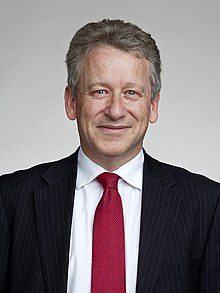| Neil GowFRS FRSE FMedSci FRSB | |
|---|---|
 Gow in 2016 Gow in 2016 | |
| Born | (1957-11-30) 30 November 1957 (age 67) Tezpur, India |
| Education | |
| Alma mater |
|
| Scientific career | |
| Fields | |
| Institutions | |
| Thesis | Growth, physiology and ultrastructure of the pathogenic fungus Candida albicans (1982) |
| Doctoral advisor | Graham W. Gooday |
| Website | www |
Neil Andrew Robert Gow (born 30 November 1957) is a British microbiologist who is a professor of microbiology and deputy vice chancellor at the University of Exeter. Previously he served at the University of Aberdeen for 38 years and retains an honorary chair there.
Education
Gow was educated Madras College and Perth Academy. He studied at the University of Edinburgh and the University of Aberdeen where he was awarded a PhD in 1982 for research on the pathogenic fungus Candida albicans supervised by Graham Gooday.
Research and career
Gow's research career has been in the field of fungal biology and medical mycology. He is known for his discoveries in fungal biology and genetics, morphogenesis and pathogenesis. His studies of how the cell walls of fungal pathogenic species is assembled, responds to antifungal antibiotics and is recognised by the human immune system directly impacts on the design and use of antifungal drugs, diagnostics and immunotherapies for fungal diseases.
After his PhD, Gow worked in Denver before returning to Aberdeen, where he has developed a team that has recently become a Medical Research Council (MRC) Centre for Medical Mycology and is one of the largest centres in this field worldwide. He has helped co-ordinate UK training and research in medical mycology and has acted as President of the British Mycological Society, the International Society for Human and Animal Mycology (ISHAM) and the Microbiology Society.
Awards and honours
Gow has received several awards for his research, he was elected a Fellow of the Academy of Medical Sciences (FMedSci), the Royal Society of Edinburgh (FRSE) and the American Academy of Microbiology. He was elected a Fellow of the Royal Society (FRS) in 2016 and a Fellow of the Royal Society of Biology (FRSB).
References
- ^ Neil Gow publications indexed by Google Scholar

- ^ Anon (2017). "Gow, Prof. Neil Andrew Robert". Who's Who (online Oxford University Press ed.). Oxford: A & C Black. doi:10.1093/ww/9780199540884.013.U286513. (Subscription or UK public library membership required.)
- Neil A. R. Gow at Library of Congress
- "University of Exeter". Exeter.ac.uk. Retrieved 28 November 2018.
- "Professor Neil Gow: Chair in Microbiology, University of Aberdeen". Aberdeen: abdn.ac.uk. Archived from the original on 17 May 2016.
- Gow, Neil Andrew Robert (1982). Growth, physiology and ultrastructure of the pathogenic fungus Candida albicans. jisc.ac.uk (PhD thesis). University of Aberdeen. OCLC 646445444. EThOS uk.bl.ethos.354942.
- Gow, Neil A. R.; Gooday, Graham W. (1982). "Growth kinetics and morphology of colonies of the filamentous form of Candida albicans". Journal of General Microbiology. 128 (9): 2187–2194. doi:10.1099/00221287-128-9-2187. PMID 6757383.
- Odds, Frank C.; Brown, Alistair J.P.; Gow, Neil A.R. (2003). "Antifungal agents: mechanisms of action". Trends in Microbiology. 11 (6): 272–279. doi:10.1016/S0966-842X(03)00117-3. PMID 12823944.
- Netea, Mihai G.; Brown, Gordon D.; Kullberg, Bart Jan; Gow, Neil A. R. (2008). "An integrated model of the recognition of Candida albicans by the innate immune system". Nature Reviews Microbiology. 6 (1): 67–78. doi:10.1038/nrmicro1815. PMID 18079743. S2CID 1477651.
- Cormack, B. P.; Bertram, G.; Egerton, M.; Gow, N. A. R.; Falkow, S.; Brown, A. J. P. (1997). "Yeast-enhanced green fluorescent protein (yEGFP): a reporter of gene expression in Candida albicans". Microbiology. 143 (2): 303–311. doi:10.1099/00221287-143-2-303. PMID 9043107.
- Butler, Geraldine; Rasmussen, Matthew D.; Lin, Michael F.; Santos, Manuel A. S.; Sakthikumar, Sharadha; Munro, Carol A.; Rheinbay, Esther; Grabherr, Manfred; Forche, Anja; Reedy, Jennifer L.; Agrafioti, Ino; Arnaud, Martha B.; Bates, Steven; Brown, Alistair J. P.; Brunke, Sascha; Costanzo, Maria C.; Fitzpatrick, David A.; de Groot, Piet W. J.; Harris, David; Hoyer, Lois L.; Hube, Bernhard; Klis, Frans M.; Kodira, Chinnappa; Lennard, Nicola; Logue, Mary E.; Martin, Ronny; Neiman, Aaron M.; Nikolaou, Elissavet; Quail, Michael A.; Quinn, Janet; Santos, Maria C.; Schmitzberger, Florian F.; Sherlock, Gavin; Shah, Prachi; Silverstein, Kevin A. T.; Skrzypek, Marek S.; Soll, David; Staggs, Rodney; Stansfield, Ian; Stumpf, Michael P. H.; Sudbery, Peter E.; Srikantha, Thyagarajan; Zeng, Qiandong; Berman, Judith; Berriman, Matthew; Heitman, Joseph; Gow, Neil A. R.; Lorenz, Michael C.; Birren, Bruce W.; Kellis, Manolis; Cuomo, Christina A. (2009). "Evolution of pathogenicity and sexual reproduction in eight Candida genomes". Nature. 459 (7247): 657–662. Bibcode:2009Natur.459..657B. doi:10.1038/nature08064. PMC 2834264. PMID 19465905.
- ^ Anon (2016). "Professor Neil Gow FMedSci FRS". London: Royal Society. Archived from the original on 29 April 2016. One or more of the preceding sentences incorporates text from the royalsociety.org website where:
"All text published under the heading 'Biography' on Fellow profile pages is available under Creative Commons Attribution 4.0 International License." --"Royal Society Terms, conditions and policies". Archived from the original on 25 September 2015. Retrieved 9 March 2016.
{{cite web}}: CS1 maint: bot: original URL status unknown (link) - "Royal Society of Edinburgh Fellows as of 2016-05-13" (PDF). Edinburgh: Royal Society of Edinburgh. Archived from the original (PDF) on 30 March 2016.
This article about a British scientist is a stub. You can help Misplaced Pages by expanding it. |
- Living people
- Fellows of the Royal Society
- Fellows of the Royal Society of Biology
- Fellows of the Royal Society of Edinburgh
- Fellows of the Academy of Medical Sciences (United Kingdom)
- 1957 births
- Alumni of the University of Edinburgh
- People educated at Perth Academy
- People educated at Madras College
- British scientist stubs